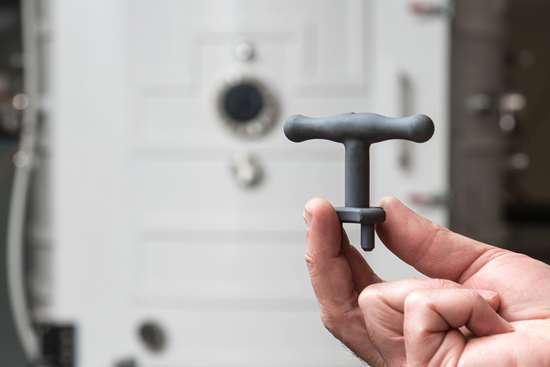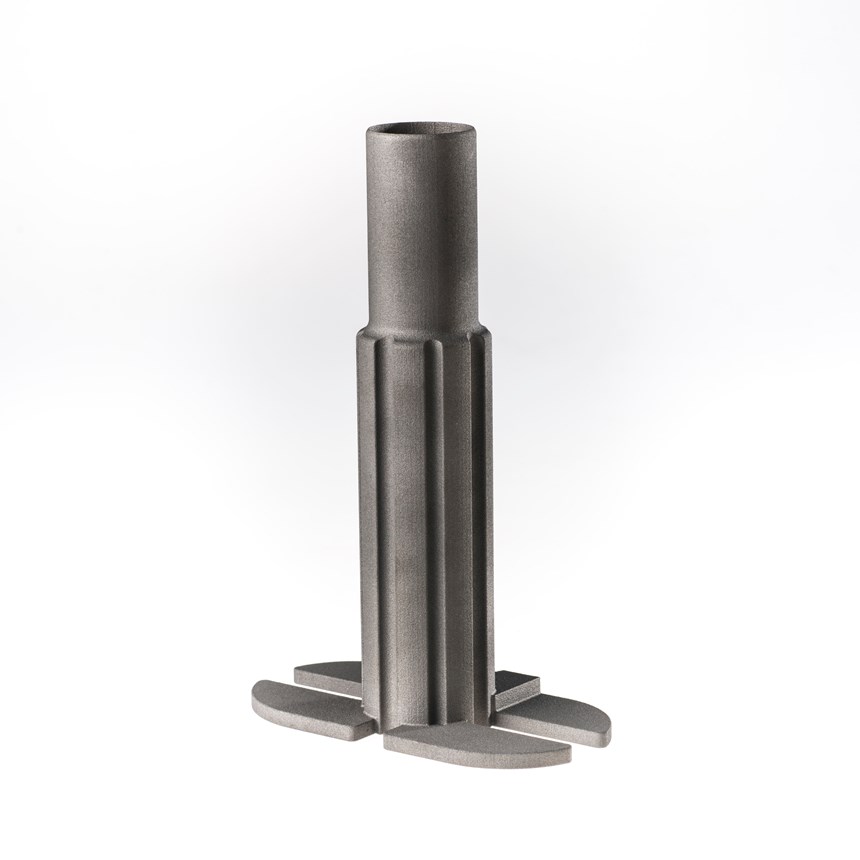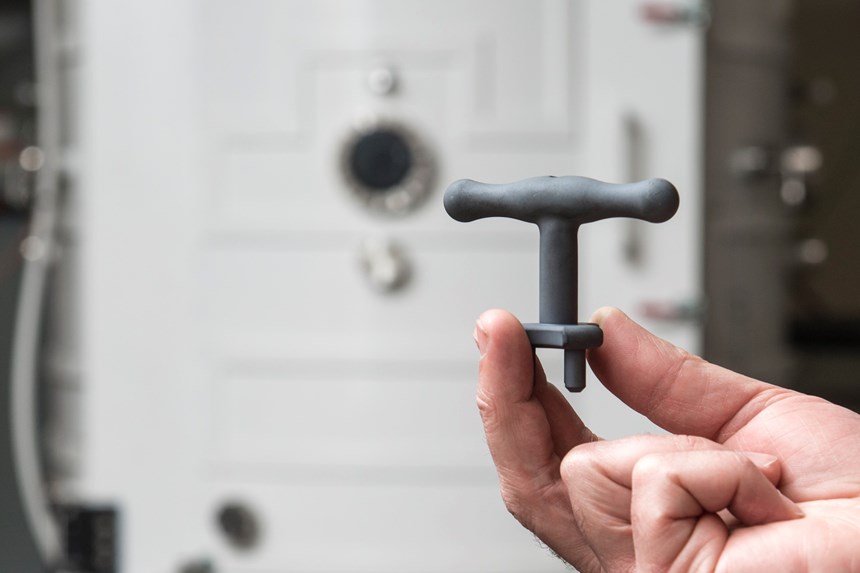PVD Coatings Solve Common 3D-Printed Mold and Part Problems
Appears in Print as: 'Coatings Plus 3D Printing '
The right surface modification solution can alleviate a few common additive manufacturing pain points that typically require creating new molds or parts.
#3dprinting
Have you tried 3D printing a mold insert only to have it underperform during the injection molding process as it succumbs to the demanding conditions? Well, surface modification may help to bridge this gap between injection molding and 3D printing. The right coating on a 3D-printed mold might prove to reduce the impact of wear, friction, harsh chemicals and materials or heat, increasing mold life and performance. This line of thinking is now extending to 3D-printed production parts, too.
It all comes down to low awareness of surface modification options and how they can solve some of additive manufacturing’s (AM) material limitations, according to John Marr, CEO of Alcadyne, located in Longmont, Colorado. He has been working with traditional molding and tooling companies for years and is now looking for companies to partner with to prove the benefits of surface modification in the world of additive manufacturing.
Featured Content
The ABCs of PVD
Alcadyne is in the thin film vacuum coating business, specializing in physical vapor deposition (PVD) and atomic layer deposition (ALD) technologies. The company coats injection molds and tools, and R&D and production parts for the semiconductor, aerospace and medical industries, with metals, ceramics, and oxides and nitrides of metals to help them hold up better against wear and tear. The company has now identified customer coating needs for both plastic and metal 3D-printed tools and parts. For example, the need for better conductivity, hardness or flame resistance.
PVD coats a material surface without requiring a medium to transfer the coating, as in plating or anodizing. This means you can coat almost any material with another metal or ceramic material. Basically, the process ionizes the atoms of the coating material. For example, PVD can ionize titanium atoms in a vacuum chamber using high energy. Here, the ionized atoms travel from the coating material (metal or ceramic) from one part of the vacuum chamber to another part of the vacuum chamber, slamming into whatever is in the way, embedding themselves into the part.
We are talking micron-layer thicknesses, so they don't knock the part out of engineering tolerances. This is why PVD is often used on injection molds that require tight tolerances but must also hold up against wear and tear.
“We call them functional coatings because we are changing the surface characteristics to hold up against friction, wear, chemicals and heat,” Marr says. “Certain PVD applied coatings also are really good release coatings.”
Coatings Plus 3D Printing
Metal and Plastic Trends Offer New PVD Coating Applications
Marr says the company is moving into coatings for additive manufacturing because they see a lot of potential for both non-metal and metal printed parts that require surface functionality that the underlying printed material cannot provide. For example a part may be printed in a lightweight material, but the benefit of that light weight may come at the cost of a weaker surface. A metal layer of a few microns in thickness may provide the hardness required for a fully functional part.
Other examples include applying a metal surface on a nonmetal surface for conductivity or grounding or coating 3D-printed parts with a protective layer to hold up against chemicals saturating or breaking down the material.
Alcadyne’s sister company, Pcomed, has been coating PEEK (polyether ether ketone) spinal implants with titanium to promote cell attachment and to eliminate the microscopic gap between bone and the implant. Alcadyne not only coats with titanium, but it also coats a nano-topology (a particular surface on the PEEK material) to promote the desired cell attachment.
“Sure, you can print in titanium, but you may not get the end result that you need because you don't have the proper surface on that titanium,” Marr says. Marr explains that you need a surface that prevents fibroblasts (a type of biological cell that plays a critical role in wound healing) from attaching to the implant and that allows osteoblasts (a cell that secretes the matrix for bone formation) to attach — not simply grow into the nooks and crannies in a porous structure. You do this with customized coatings.
The trend of titanium-printed parts has revealed that the bone may pull back from the titanium over time, preventing good cell attachment. The titanium part often does not have the proper surface topology, as cell types are attracted to certain surface structures.
Printing two different metals is another AM trend, but one that is not without its problems. For example, one of Alcadyne’s electronics customers prints two metals on a single part, then plates the part with gold. Etching was required before gold plating, but the two metal surfaces had inhomogeneous etching starts, leading to different etch depths, which negatively impacted the plating process. Alcadyne’s solution was to coat the entire part in copper, which yielded uniform etching of the copper before plating. Today, they are taking it even further by coating the whole part in gold and skipping the etching and plating processes altogether.
Another customer was printing a part in Kovar (an iron-nickel-cobalt alloy with a coefficient of thermal expansion similar to that of hard glass) that was oxidizing over time. As a result, the customer started printing stainless on top of the Kovar to encapsulate it to prevent oxidation. Alcadyne’s solution was to PVD coat stainless steel onto the Kovar, which was much faster and cheaper than printing the stainless on top of the Kovar.
“One advantage of PVD over plating is that we are not restricted to certain types of metals and we can coat special alloys,” Marr says. Alcadyne coats parts with those alloys in a PVD chamber. It is possible to coat in different metals, such as zirconium, chromium, nickel, titanium, stainless steel, silver, gold, and nitrides and oxides of those metals.
Coating odd geometries for functionality is another benefit of PVD and ALD. 3D printing can print very intricate shapes and geometries, such as conformal-cooled channels for injection molds or single-printed parts that would typically require custom welding. Alcadyne can put a functional coating on these geometries as well. And for cooling channels, in particular, the company has a specially formulated coating to create a smooth surface to decrease scaling and corrosion. This same coating can be used to seal leaks in the cooling channels, should they occur.
PVD has advantages in 3D-printed plastic parts as well. For example, Alcadyne coated a nylon-printed part for the semiconductor industry with stainless steel to protect the nylon from a polishing slurry that the company was using for cleaning. They coat nylon oilfield bushings with stainless steel to prevent wear and tear from friction and oil saturating the nylon material. They also can coat nonmetal aerospace parts with metal for grounding purposes and coat plastic materials in copper for conductivity.
Coating and Process Selection
When deciding which coating is best for an application, Marr recommends first asking what you are trying to accomplish with the part. For example, one customer wanted ALD coating on a part to prevent any pin holes in the coating, so that chemicals couldn't get in, and although ALD is good for that, the company recommended a PVD coating followed up with an ALD coating to prevent any chemical incursion.
“The goal is to create the surface characteristic needed so that the final product functions in the way that the customer envisions,” Marr says.
Attachment limitations with the substrate material do exist, which is where the art of coating comes into play. Marr says that the magic of coating lies first in proper surface preparation, then setting coating parameters for best adhesion, which is custom for every substrate size, shape and material.
Surface preparation, cleaning and handling is key. “Metals are a lot easier than nonmetals, as they do not absorb oils and are not as porous as the nonmetals, so there is no trapped air, for example. Nonmetal parts are more porous and take longer to prep ahead of time for cleaning and to prep within the vacuum chamber,” Marr says.
Alcadyne experiments with different pressures and energy levels to get proper adhesion of the alloy into the substrate or part. Trial-and-error is the name of the game once you step outside of common coating materials.
For More Information
RELATED CONTENT
-
How to Choose the Right Tool Coating for Your Machining Application
Selection criteria and common coating attributes for PVD, CVD and other common coatings.
-
Advantages and Disadvantages of Copper and Graphite Electrodes
Both copper and graphite provide approximately the same end result, so it is important for a shop to consider the advantages and disadvantages of each material in order to discover what would work best in their shop floor environment.
-
10 Considerations for Choosing a Robot
Knowing what to look for is essential when comparing and evaluating robots from different manufacturers.
















